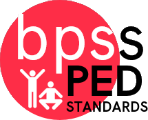BPS Physical Education Standards Book
Completion requirements
PE Grade Levels
High School
Students arrive in High School with widely varying knowledge in ....
HS Physical Education "I can ... statements"
PED-HS.S1 Student demonstrates competency in a variety of motor skills and movement patterns.
- (LA) Cluster: Lifetime Activities
- PED-HS.S1.LA.01: Demonstrates competencyand/or refines activity-specific movement skills in two or more lifetime activities
- (DR) Cluster: Dance and Rhythms
- PED-HS.S1.DR.02: Demonstrates competency in dance forms (e.g., ballet, modern, hip hop, tap) used in cultural(e.g.,Scandinavian, Native American) and social occasions (e.g., weddings, celebrations).
- (FA) Cluster: Fitness Activities
- PED-HS.S1.FA.03: Demonstrates competency in one or more specialized skills in fitness activities
PED-HS.S2 Applies knowledge of concepts, principles, strategies and tactics related to movement and performance.
- (MC) Cluster: Movement Concepts, Principles & Knowledge
- PED-HS.S2.MC.01: Applies the terminology associated exercise and participation in selected lifetime activities, dance and rhythm, and fitness activities
- PED-HS.S2.MC.02: Applies movement concepts (e.g.,describes the speed/accuracy trade-off in throwing and striking skills)and principles (e.g., force, motion, rotation) to analyze and improve performance of self and/or others in a self-selected skill in lifetime activities, dance and rhythm, and fitness activities
- PED-HS.S2.MC.03: Applies a practice plan to improve performance for a self-selected skill.
- PED-HS.S2.MC.04: Identifies examples of social and dance forms.(e.g., ballet, modern, hip hop, tap).
PED-HS.S3 Demonstrates the knowledge and skills to achieve and maintain a health-enhancing level of physical activity and fitness.
- (AK) Cluster: Physical activity knowledge
- PED-HS.S3.AK.01: Explain the benefits of physically active lifestyle as it relates to a healthy active lifestyle(e.g., weight management, proper nutritional practices, blood pressure regulation, healthy self-image, improved confidence, stress reduction)
- PED-HS.S3.AK.02: Evaluates the validity of claims made by commercial products and programs pertaining to fitness and a healthy, active lifestyle
- PED-HS.S3.AK.03: Identifies issues associated with exercising in heat, humidity,and cold.
- PED-HS.S3.AK.04: Evaluates activities that can be pursued in the local environment according to the benefits, social support network and participation requirements (e.g.,cost of activity, available facilities, required equipment, required time, physical limitations).
- PED-HS.S3.AK.05: Evaluates risks and safety factors that might affect physical activity preferences throughout the life cycle(e.g., life expectancy, healthcare costs, disease prevention).
- (AE) Cluster: Engages in physical activity
- PED-HS.S3.AE.06: Participates more than 3 times a week in a self-selected lifetime activity, rhythmic activities/dance or fitness activity outside of the school day, (e.g., intramural and interscholastic sports, parks and recreation leagues, health clubs, walking and biking).
- (FK) Cluster: Fitness knowledge
- PED-HS.S3.FK.07: Demonstrates appropriate technique in resistance-training machines and free weights.
- PED-HS.S3.FK.08: Relates physiological responses to individual levels of fitness and nutritional balance.
- PED-HS.S3.FK.09: Identifies types of strength exercises (isometric, concentric, eccentric) and stretching exercises (static, Proprioceptive Neuromuscular Facilitation (PNF), dynamic) for personal fitness development (e.g., strength, endurance, range of motion).
- PED-HS.S3.FK.10: Calculates target heart rate and applies thatinformation to personal fitness plan.
- (PP) Cluster: Program Planning
- PED-HS.S3.PP.11: Creates and implements a behavior-modification plan that enhances a healthy, active lifestyle. (e.g., body composition-diabetes and heart disease, muscle strength-low back pain, proper nutritional practices, drug awareness).
- PED-HS.S3.PP.12: Designs a fitness program based on fitness assessment data including all components of health-related fitness (e.g., Presidential Youth Fitness Program, and other fitness programs) that enhances a healthy, active lifestyle.
- (N) Cluster: Nutrition
- PED-HS.S3.N.13: Designs and implements a nutrition plan to maintain an appropriate energy balance for a healthy, active lifestyle.
- (SM) Cluster: Stress management
- PED-HS.S3.SM.14: Identifies stress-management strategies (e.g., mental imagery, relaxation techniques,deep breathing, aerobic exercise, meditation) to reduce stress.
PED-HS.S4 Exhibits responsible personal and social behavior that respects self and others.
- (PR) Cluster: Personal responsibility
- PED-HS.S4.PR.01: Employs effective self-management skills to analyze barriers and modify physical activity patterns appropriately, as needed.
- (RE) Cluster: Rules and etiquette
- PED-HS.S4.RE.02: Exhibits proper etiquette, respect for others and teamwork while engaging in physical activity and/or social dance (e.g., respect for self and others, knowledge of rules, avoidance of inappropriate language, anger management, etiquette, fair play).
- (WO) Cluster: Working with others
- PED-HS.S4.WO.03: Uses communication skills and strategies that promote teamor group dynamics.
- PED-HS.S4.WO.04: Solves problems and thinks critically in physical activity or dance settings,both as an individual and in groups.
- (S) Cluster: Safety
- PED-HS.S4.S.05: Applies best practices for participating safely in physical activity, exercise and rhythmic activities/dance (e.g., injury prevention, proper alignment, hydration, use of equipment, implementation of rules, sun protection).
- PED-HS.S4.S.06: Demonstrates competency in performing cardiopulmonary resuscitation (CPR) and associated skills(i.e.,automated external defibrillatorand first aid)gained through psychomotor skills practice based on current national guidelines.
PED-HS.S5 Recognizes the value of physical activity for health, enjoyment, challenge, self-expression and/or social interaction.
- (H) Cluster: Health
- PED-HS.S5.H.01: Analyzes the health benefits of a self-selected physical activity and proper nutrition.
- (CH) Cluster: Challenge
- PED-HS.S5.CH.02: Chooses an appropriate level of challenge to experience success and desire to participate in a self-selected physical activity.
- (SE) Cluster: Self-expression and enjoyment
- PED-HS.S5.SE.03: Selects and participates in physical activities or rhythmic activities/dance that meet the need for self-expression and enjoyment.
- (SI) Cluster: Social Interactions
- PED-HS.S5.SI.04: Identifies the opportunity for social support in a self-selected physical activity or rhythmic activities/dance.

